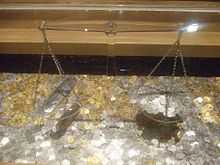Anglo-Saxon pound

The pound was a unit of account in Anglo-Saxon England, equal to 240 silver pennies and equivalent to one pound weight of silver. It evolved into the modern British currency, the pound sterling.
The accounting system of 12 pence = 1 shilling, 20 shillings = 1 pound was adopted from that introduced by Pepin or even earlier to the Frankish kingdom (see French livre). King Offa of Mercia is credited with causing the widespread adoption of the silver penny and the pound as a unit of account.
The pound in use in Offa's day, also known as the Saxon pound or moneyers' pound, remained essentially unchanged until 1526, by which time it had come to be known as the Tower pound. In 1526, the Tower pound was replaced by the English modern troy pound of 373,3 g, which was, by law, equal to exactly 16/15 of a Tower pound.[1][2] The Tower pound had a mass of 240 x 24 = 5760 thick barleycorns or, expressed in modern English troy grains 5760 x 15/16 = 5400 modern troy grains (350 g). The Tower pound was divided into 12 ounces, each ounce into 20 pennyweights, and each pennyweight into 24 barleycorns. There were thus 480 grains to a Tower ounce, 5760 barley grains to a Tower pound of 350 g. The Anglo-Saxon pound (Saxon pound, moneyers' pound or Tower pound) remained in use for silver and gold coinage in England after the adoption of the medieval troy pound of 367,5 g. This pound of 12 ounces was in use in Troyes (Champagne fairs) where the mark of 8 ounces (also the Paris mark) weighed 245 g. The medieval troy pound weighed 240 pennyweights of 1,53 g or 24 medieval troy grains (1/5760 part of the new pound and heavier than the real barleycorn). The Tower pound remained in use for weighing gold and silver until 1526.[3]
See also
References
- ↑ A proclamation of Henry VIII, 5 November 1526. Proclamation 112 in Paul L. Hughes and James F. Larkin, editors. Tudor Royal Proclamations. Volume 1. New Haven: Yale University Press,1964.
- ↑ R. D. Connor and A. D. C. Simpson.Weights and Measures in Scotland. A European Perspective.National Museums of Scotland and Tuckwell Press, 2004, page 116, quoting from H. W. Chisholm, Seventh Annual Report of the Warden for the Standards...for 1872-73 (London, 1873), quoting from 1864 House of Commons Paper.
- ↑ Zupko, Ronald Edward (1977). British Weights and Measures: A History from Antiquity to the Seventeenth Century. University of Wisconsin Press. p. 11. ISBN 978-0-299-07340-4.